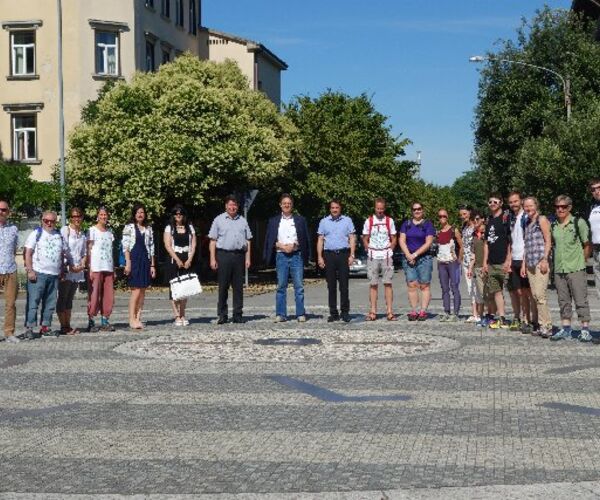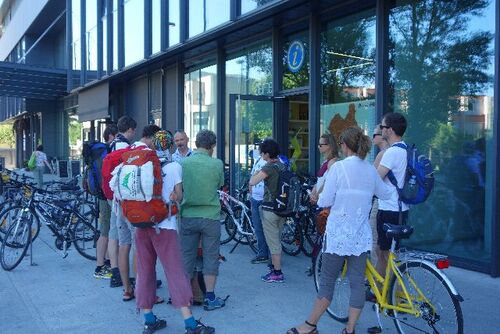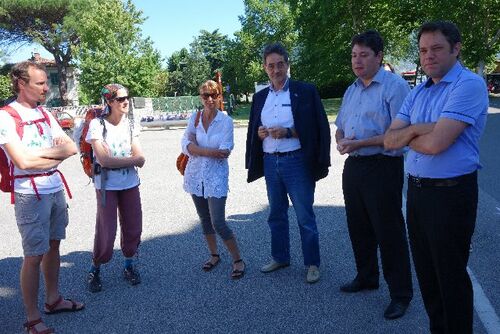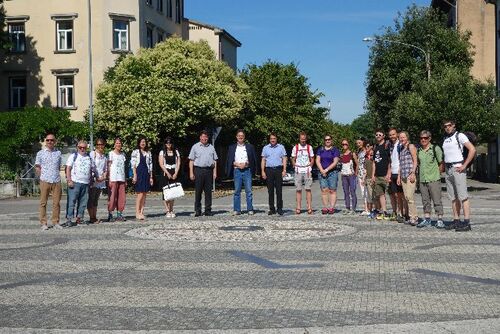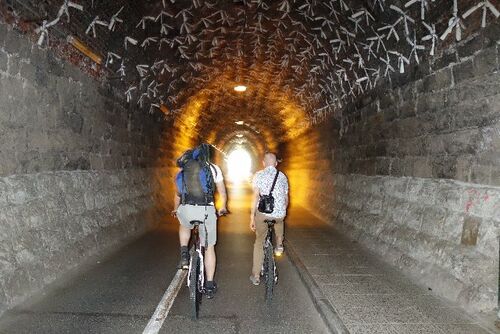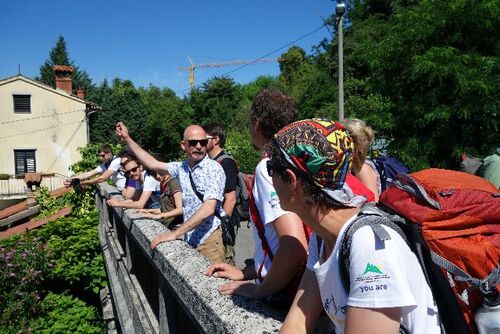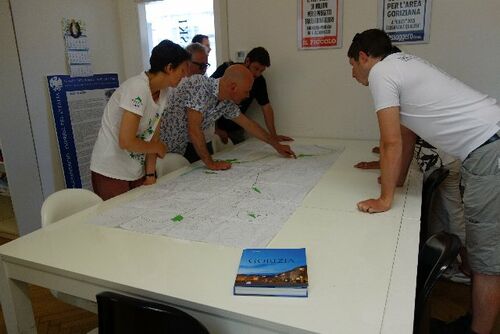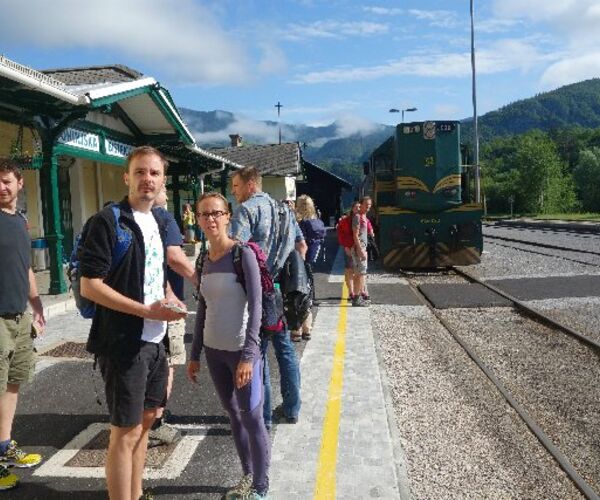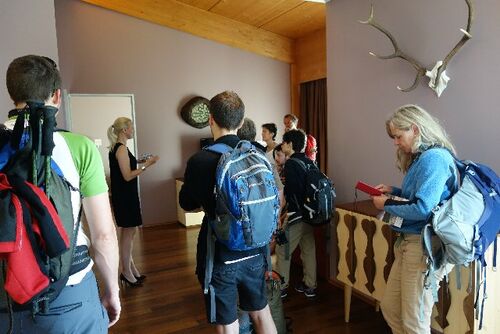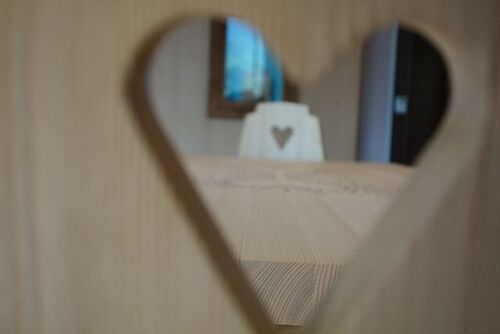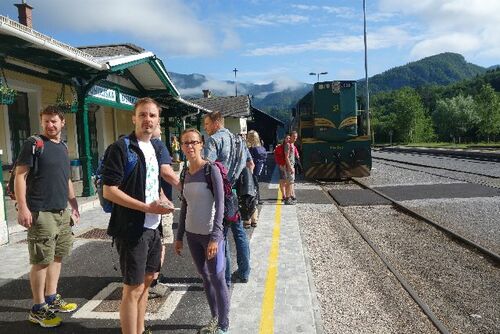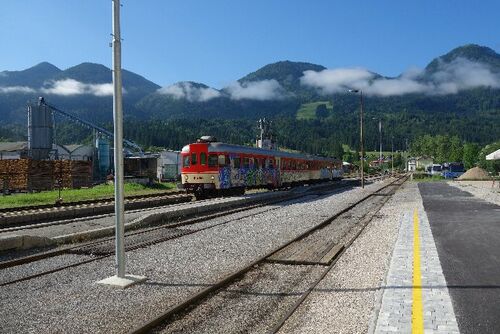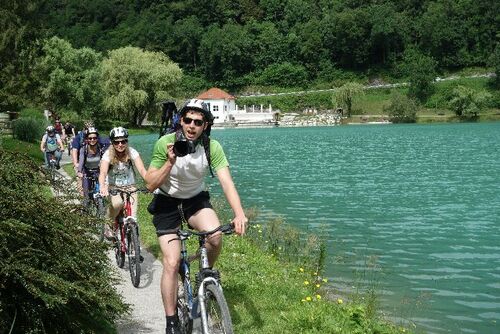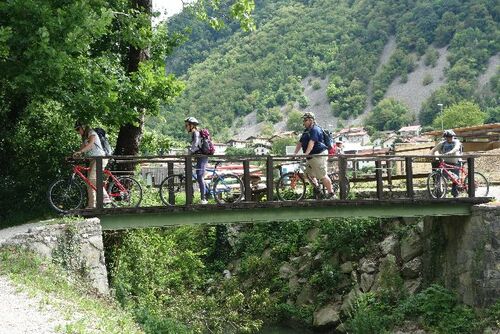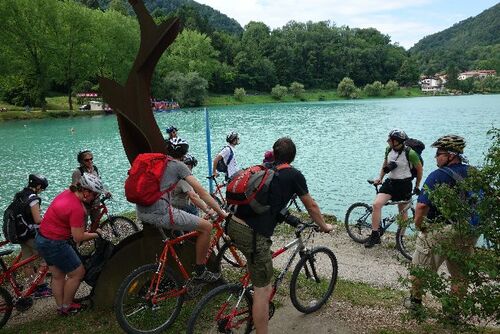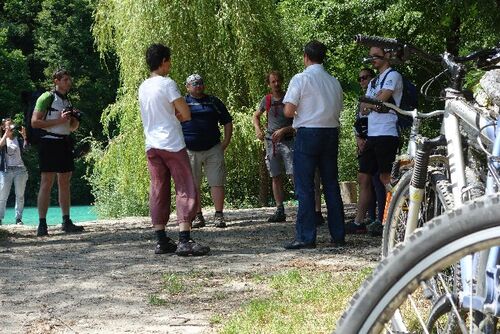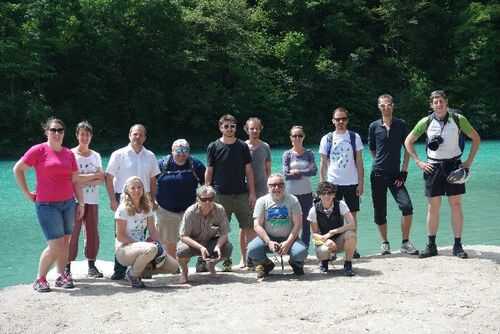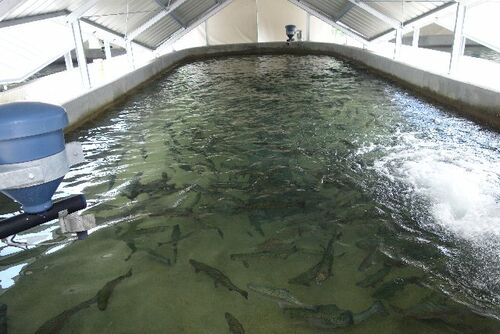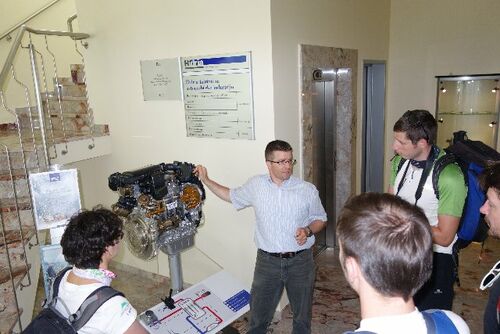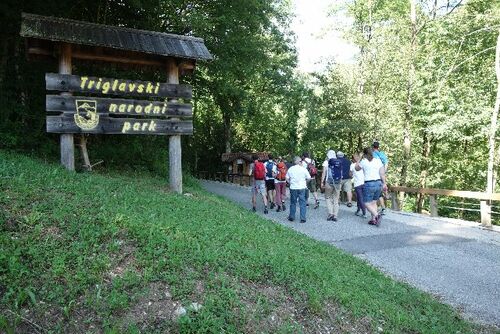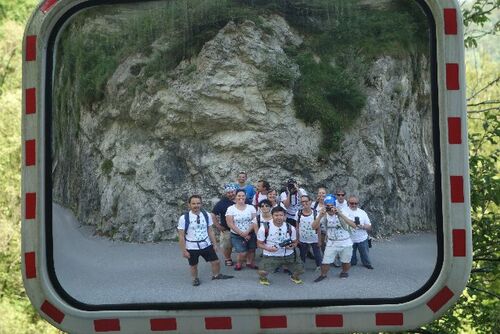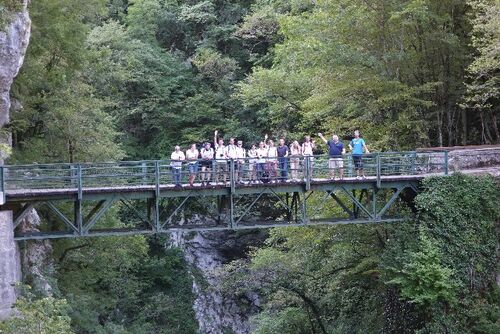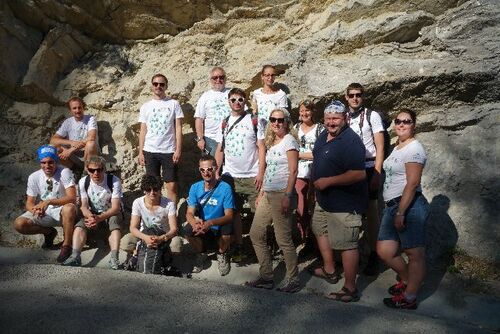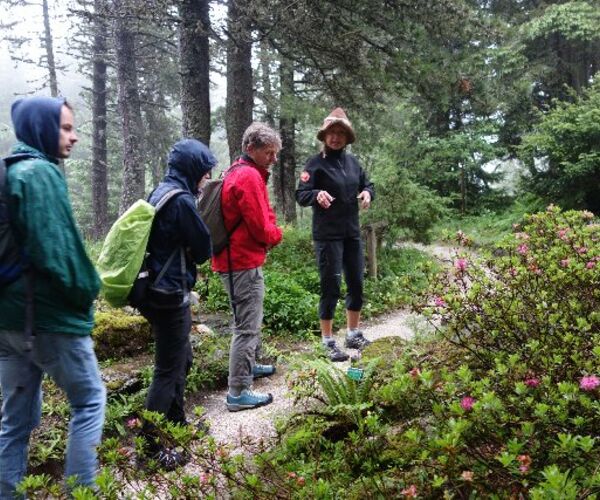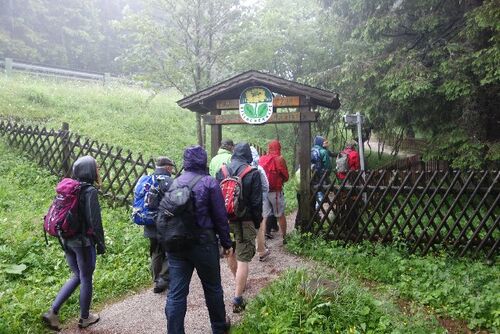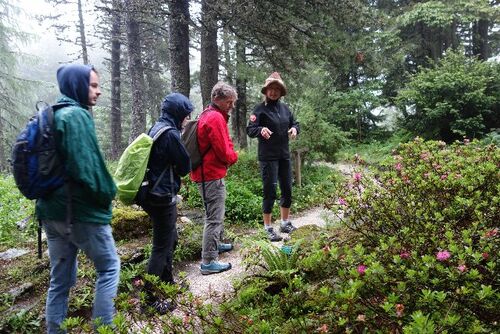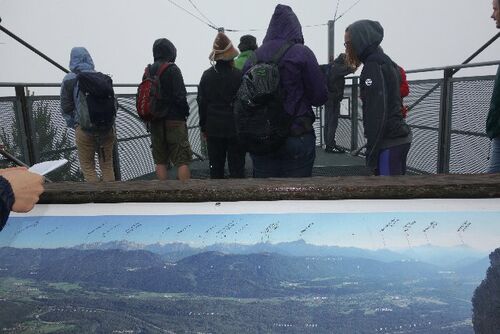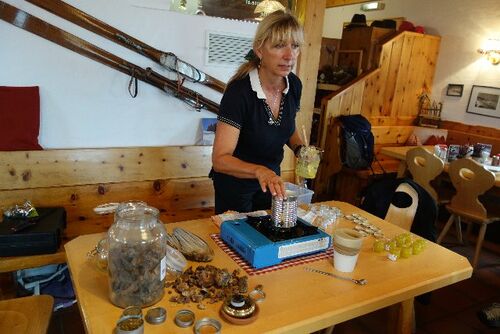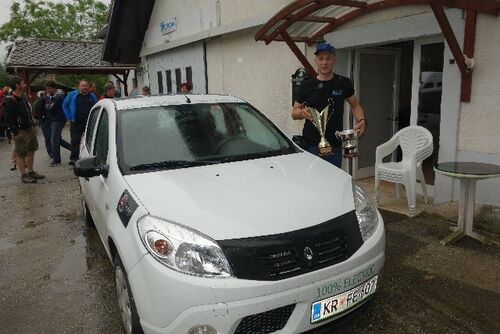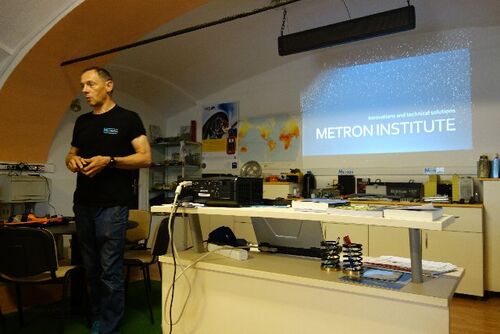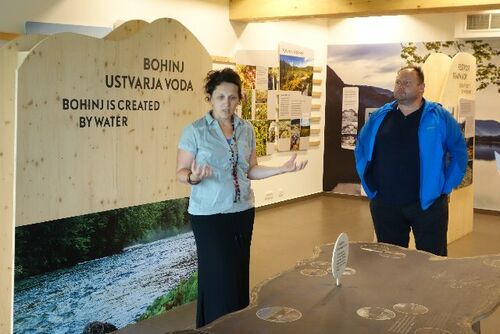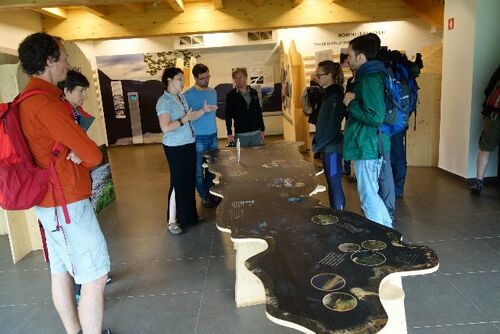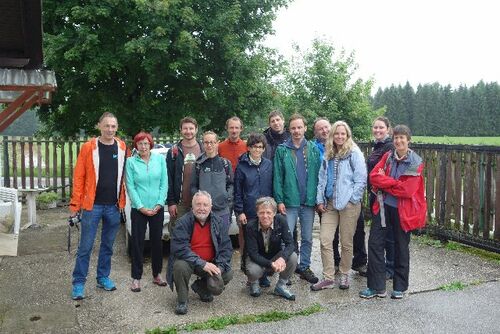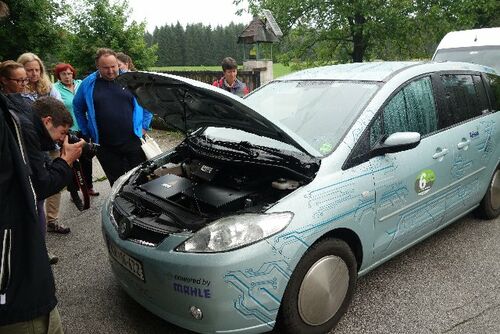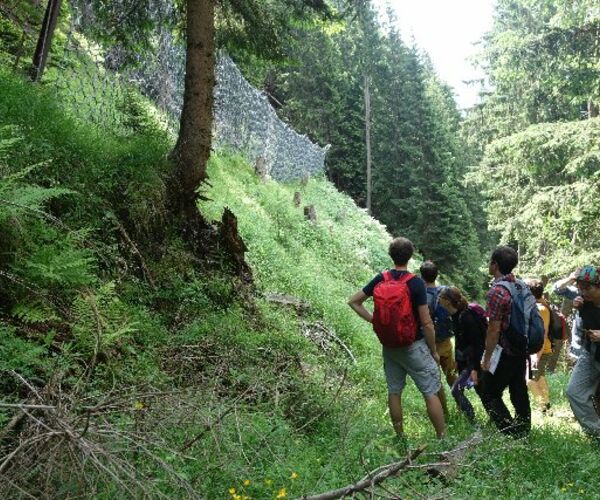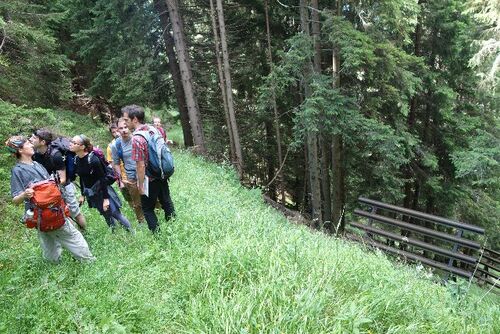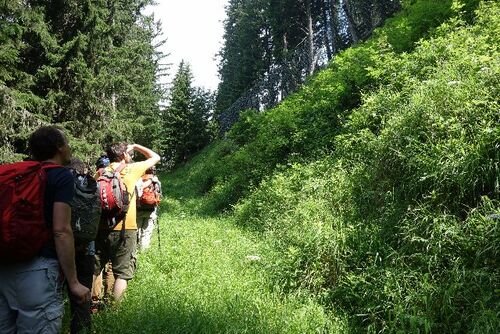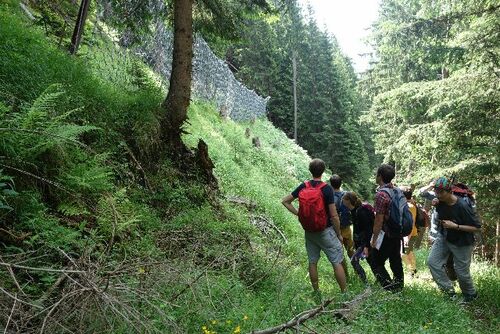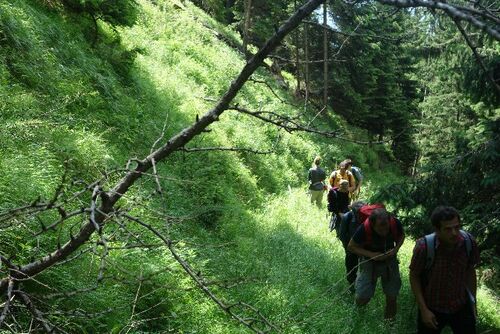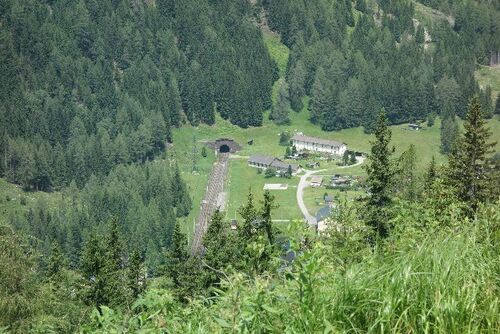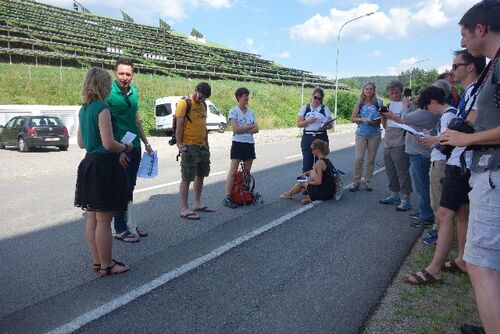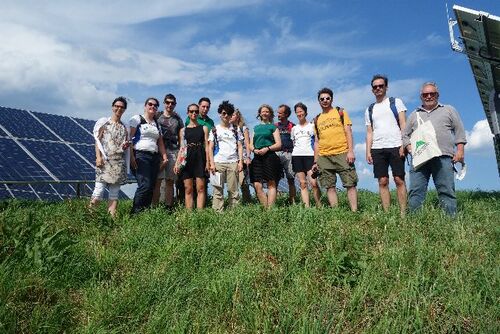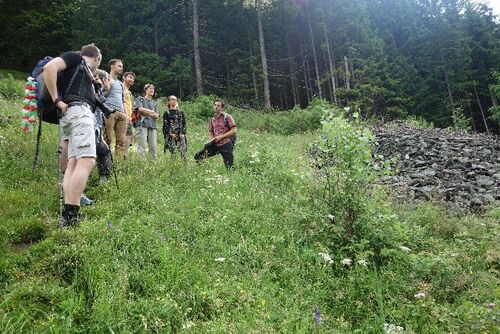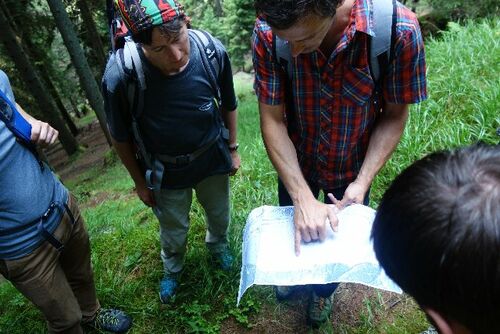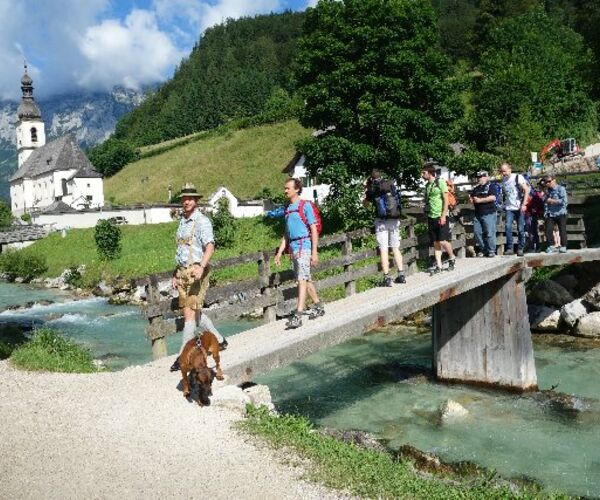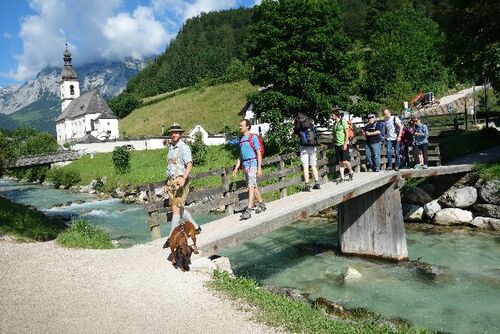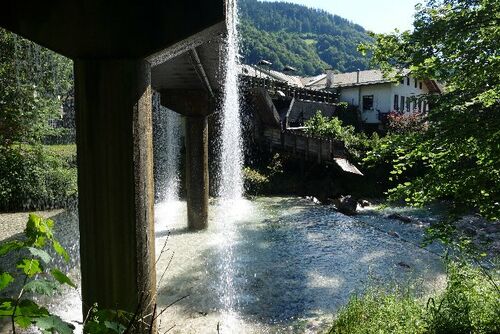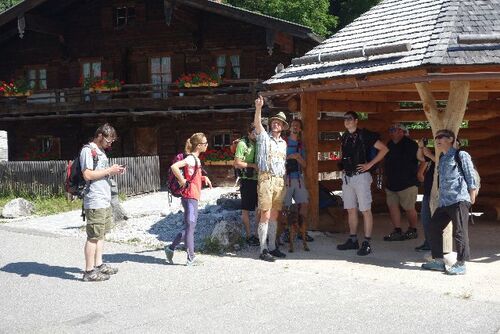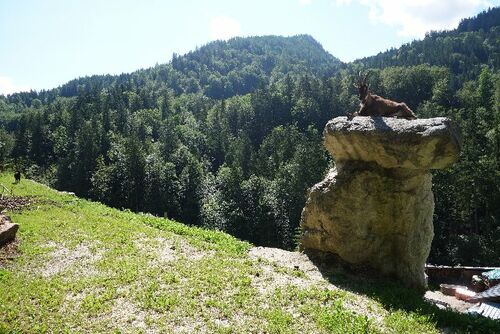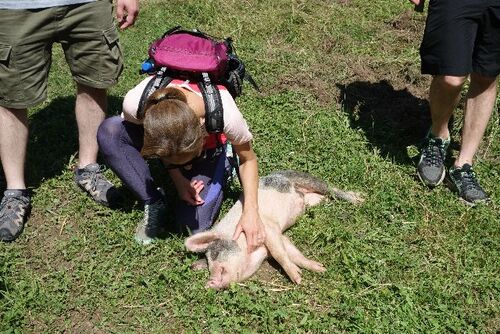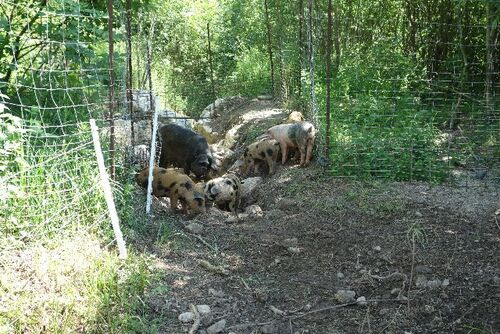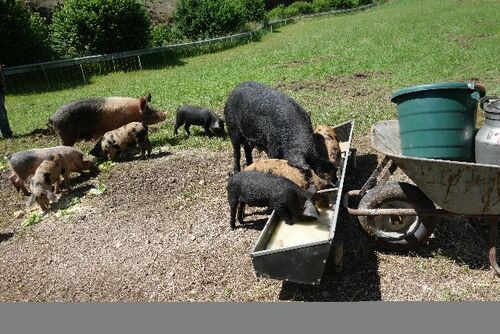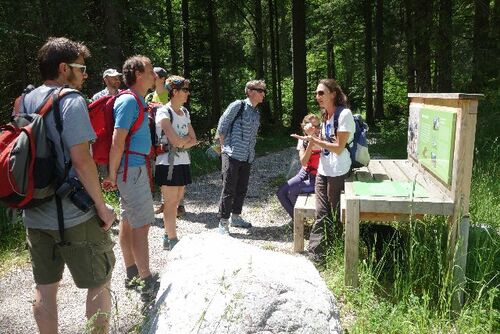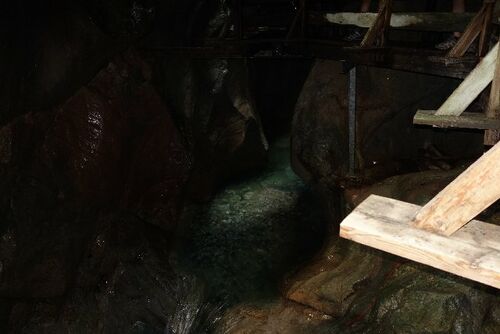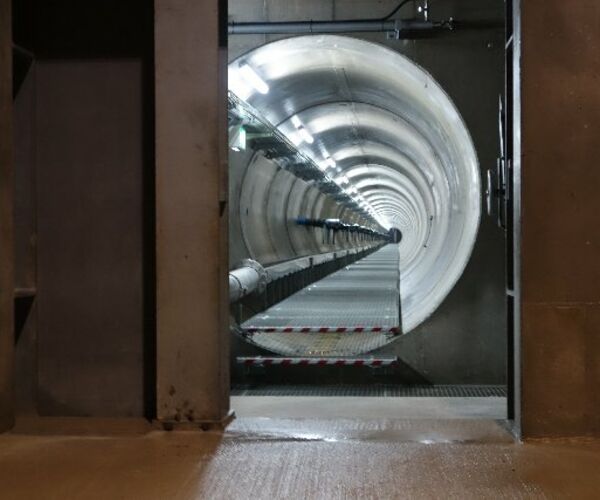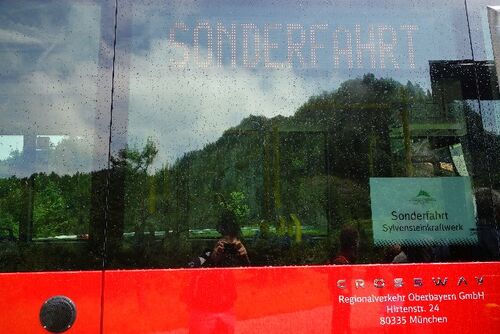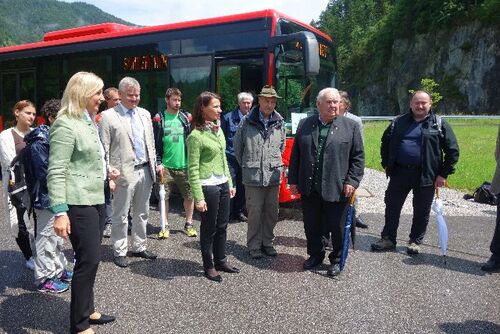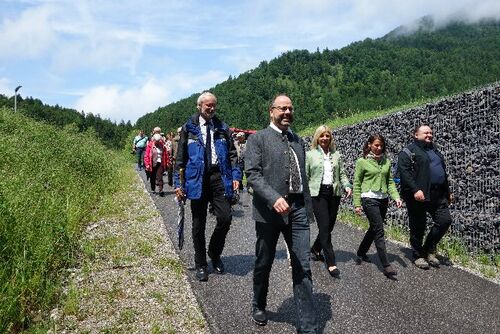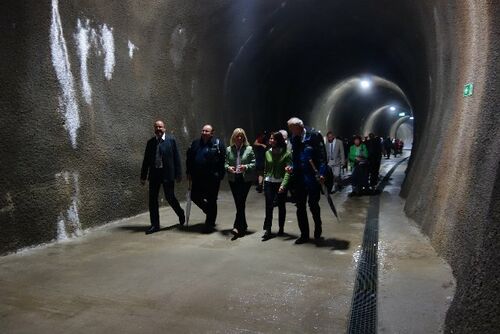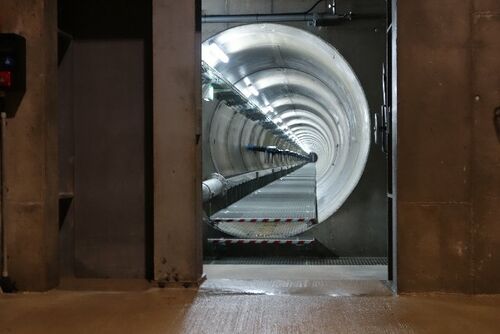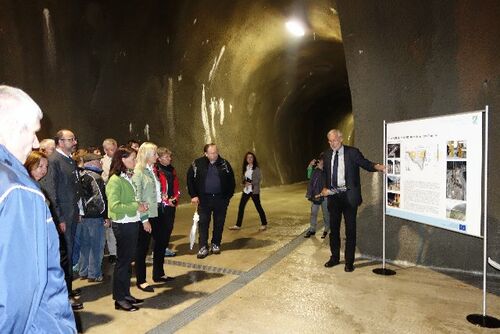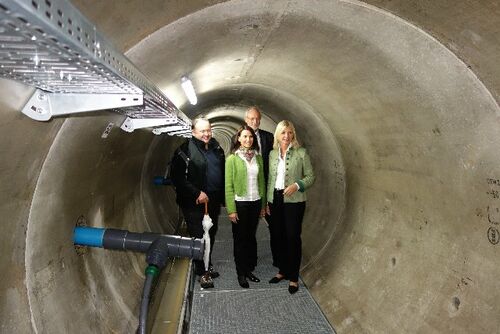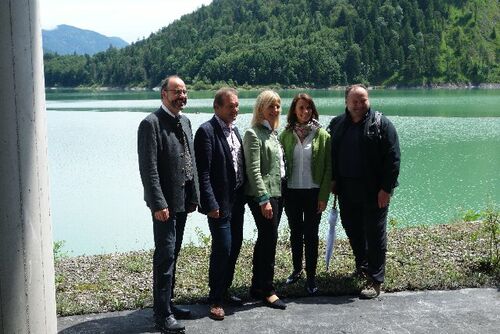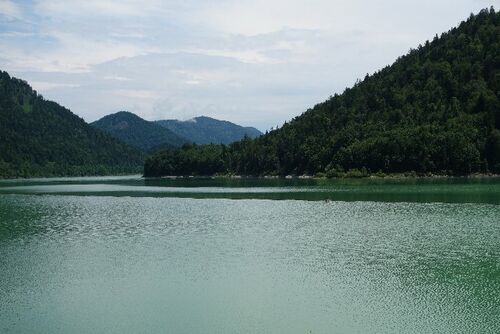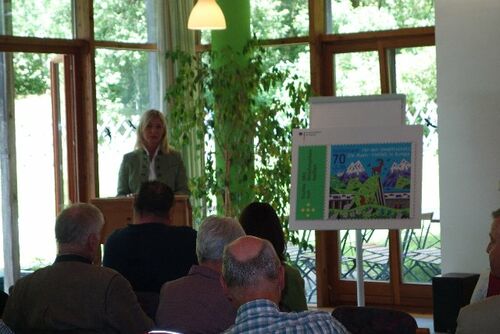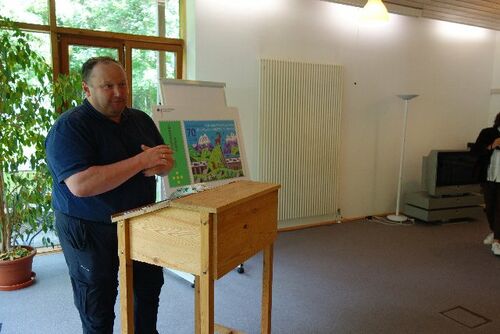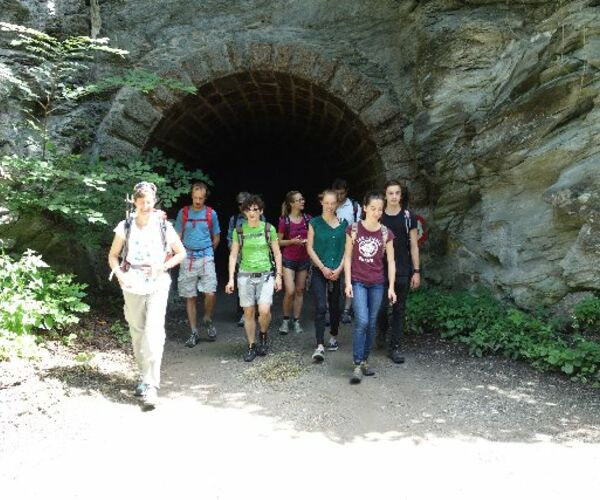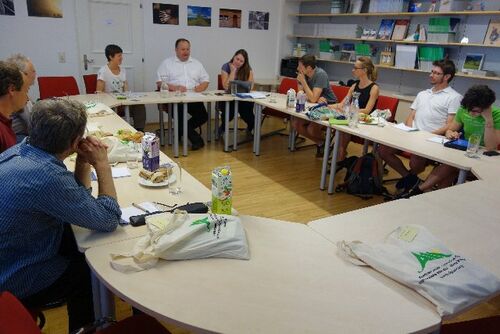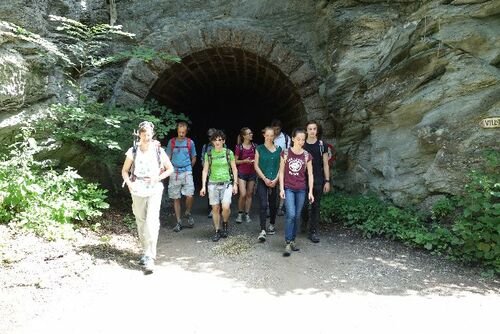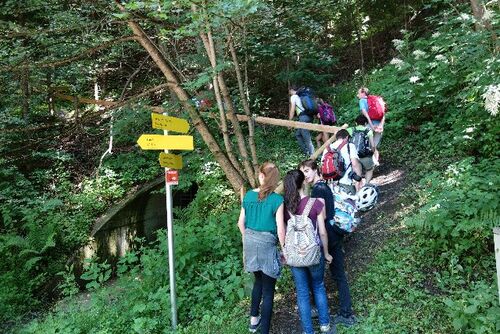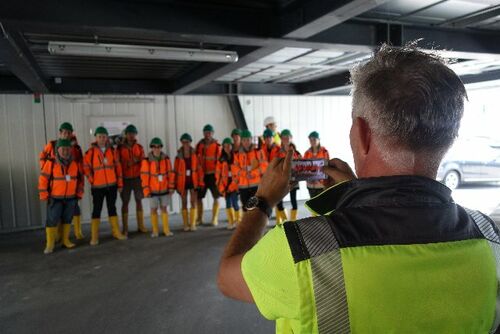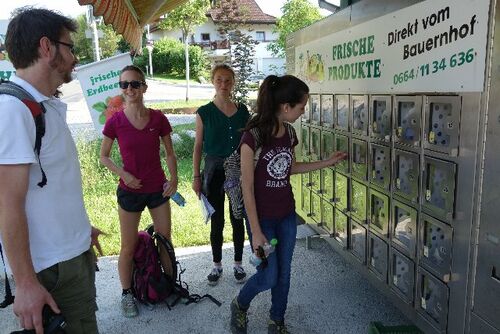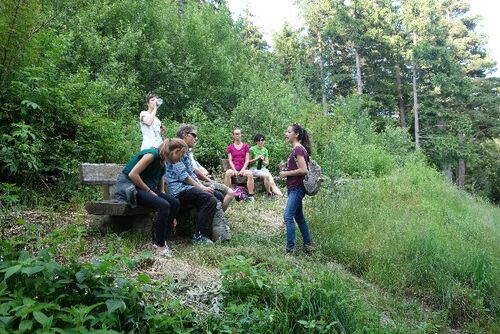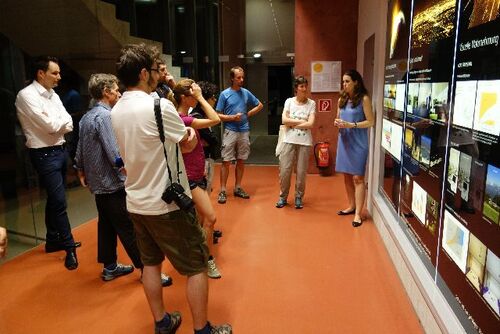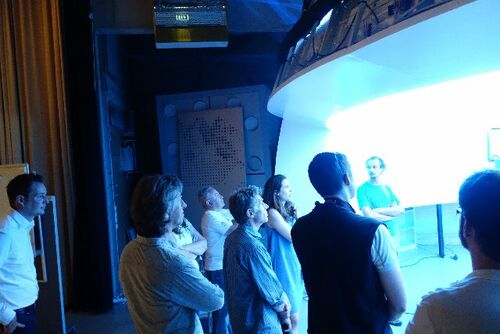We are Alps Tour 2016
The 2016 edition of the We are Alps tour was looking for answers what “Green Economy” is and how is it happening in the Alps – is it different from the lowlands, what are its characteristics and what good practice examples can be found across the Alps (with focus this year on the Eastern Alps).
A selected group of journalists participated in the tour taking place between 29 June and 5 July 2016 on a route linking Innsbruck (AT) and Gorizia (IT). Activities on the topic of Green Economy in the Alps, including energy efficiency in lighting and building, renewable energy production, sustainable use of natural resources, ecosystem services and natural capital-based economy, and overall economic development as the basis for a good quality life in the Alps, were carried out in Austria, Germany, Slovenia and Italy. As always in the We are Alps tour, the group travelled exclusively by sustainable means of transport, i.e. train, bus, bike and on foot.
The participants had the opportunity to meet the actors of flagship projects contributing to innovative approaches on topics such as water and forest management, spatial planning, transport, tourism, farming, energy production and savings and many more. The tour was organized in close cooperation with local partners, stakeholders and observer organization.
Alpine green economy is also the topic of the upcoming Report on the State of the Alps that was later be presented to the Alpine ministers in October and the participants at the tour will have a chance to catch a glimpse on the reality of it.
Blog
written by: Maja Prijatelj Videmšek
From the light into the dark and from there to the light again. This is how the first day of We are Alps tour 2016 started. Group of journalists from Italy, Switzerland, Slovenia and Austria, keen to explore the beauty of the Alps by sustainable means of transport, met in the XV-th century Golden Roof building in the heart of Innsbruck old town. From the building’s famous balcony Emperor Maximilian I. used to observe bustling street life below him.
But late Middle Age is long gone and era of Kaiser Maximilian is only remembered while visiting to the museum in the “Goldenes Dachl”. Today the building harbours the Permanent Secretariat of the Alpine Convention, which provides support to the bodies established by the Alpine Convention. Have you already heard about the Alpine Convention? If you are citizen of the EU, there is a high probability, that you live in its perimeter, even if you are not aware of this. Alpine Convention is ian nternational treaty for the protection and the sustainable development of the Alps, a home of 14,2 million people in eight countries (Austria, France, Germany, Italy, Liechtenstein, Monaco, Slovenia and Switzerland). They share diverse beauty of snow covered peaks, Alpine meadows and wild rivers, but at the same time face similar threats and challenges. The Alpine region is experiencing climate change faster than other parts of Europe. The average temperature increase is already twice as high as in the Northern hemisphere.
With this worrying fact in mind Markus Reiterer, Secretary General of the Alpine Convention, welcomed us at the beginning of seven days trip, starting in the capital of Tyrol and ending in Nova Gorica/Gorizia, a city shared by Slovenia and Italy. While last year journalistic team experienced global warming first hand at the highest European railway station in Europe on Jungfraujoch, where the temperature reached historic record high, this year’s main topic of the trip is going to be green economy. The Alpine region is green, indeed, but the main task is how to achieve, that green will also be the first word to come to mind when thinking about its economy and way of living in general? We will get some proposals with the sixth Report on the State of the Alps, focusing on Greening the economy in the Alpine region – from the niche to a guiding principle, which is currently being elaborated by an ad-hoc working group and will be presented to the Alpine Conference in October.
One of the endeavours, in fact one of the most important infrastructural projects in Europe at the moment, also addressing the challenge of greening the economy, is the construction of the Brenner railway tunnel. The Brenner pass motorway, one of the main traffic routes through the Alps, which connects Innsbruck in Austria to Modena in Northern Italy, faces traffic jams almost on a daily basis. With 2 million trucks driving over the Brenner pass per year it couldn’t be different. But this should change with building 64 kilometres long Brenner railway tunnel.
When it will come into operation in 2026, it is believed, that 80 % of the road freight transport will shift from road to rail, but also passenger trains will travel through the tunnel. Moving the majority of heavy truck traffic to the Alpine underground will also lower its impact on environment, since rail transport has lower carbon emissions than road transport. Thanks to the virtually horizontal tunnel train traffic will no longer have to contend with the steep up- and downhill slopes on the Brenner railway line that by now is over 140 years old.
2026 sounds far away, but if you know the fact, that for these 64 kilometres of the tunnel workers have to build additional 230 kilometres of access, connection and exploratory tunnels, ten more years at once sound quite optimistic. In one day workers build about eight metres of tunnel. There are about 500 of them, working in shifts, seven days per week, using conventional blast and drill method as well as state of the art boring machine with large cutter head, constructed especially for building of Brenner tunnel. The machine is 200 metres long, weighs 1800 tons and it pushes the solid rock with the power of ten Ferraris, Andrea Lussu, project coordinator in charge of tunnel construction work in Aldrans, explained.
From the dark tunnel, where detonations hit the air every once in a while a hike through the intensive green countryside towards Aldrans was really invigorating. At one point we stopped on small wooden bridge across a little stream with rush and micro frogs inside, but didn't realise that 300 metres below the surface major construction work is taking place. Along the way two members of the youth parliament of the Alpine Convention (YPAC) explained us what solutions for the greener future the young generation of Alpine leaders is discussing about.
Just before a magnificent sunset behind Innsbruck’s home mountain range, Nordkette, we reached the company headquarters of Bartenbach in Aldrans. The family company, established in 1976 by Christian Bartenbach, is a world market leader in sustainable lighting systems. It has strong research and development department, where they study the impact of the light on human body and provide individually tailored solutions. What is the optimum lighting in the dining rooms, office spaces, shopping malls, hotels, cities, ski slopes? They have the answers for all these questions. Julia Schauer (Senior Consultant) and Frank Bunte (Director Consulting) revealed us part of their philosophy: “One should never feel where the light is coming from”. Their innovations are not only kind to the people but also to the environment, because they reduce light pollution and don’t harm nocturnal animals, such as insects, among which there are many pollinators. These masters of balance between light and dark are a supreme example of green economy in the Alps.
Follow our adventures tomorrow, when we’ll visit Ramsau, the first German member of Mountaneering villages!
written by: Maja Prijatelj Videmšek
On Thursday morning we waved goodbye to tourist packed Innsbruck and took series of trains and busses towards a more peaceful part of the green Alps, village of Ramsau, the first German municipality member of the Mountaineering Villages network.
On the way there we stopped at the Sylvenstein reservoir, where we shook hands with the German Parliamentary State Secretary Rita Schwarzelühr-Sutter and the Bavarian State Minister of the Environment Ulrike Scharf. Together we visited the site of new sealing and control system at the Sylvenstein Reservoir, located on a 100 meter deep valley cut, which the Isar River carved.
Since its commissioning in 1959 the reservoir has helped flood mitigation in the Munich metropolitan area and protects the Isar runoff in dry seasons by supplying water. At the same time environment-friendly electricity is generated for the public grid. Due to the fissures in the dam core and damaged seepage flow measurement system they had to construct the cut-off wall, control gallery and drainage piles. This will enable the dam to operate for many more decades, and handle future flood events well and reliably. This has already been impressively confirmed during the flood event in June of 2013 and also during recent floods, where large parts of Germany were under water.
There is 3,1 billion Euros worth flood prevention programme for Bavaria, but state’s Environment Minister Scharf announced, she will ask the federal government for more funding for the flood prevention.
At the event Scharf awarded nine people from the region for their commitment to sustainable development in the Alpine area and presented the post stamp with slogan of the German presidency to the Alpine Conference: The Alps – Diversity in Europe. Stamp costs one euro, of which 30 cents goes to special fund, handled by German ministry of the environment. It is planning to raise about 250.000 Euros, and divide this amount to sustainable projects in the Alpine region.
It takes about five hours from Sylverstein Reservoir to Ramsau, and we had to take five trains and five busses to get there. Quite an achievement, if you are tourist travelling on your own, but with our patient and perfectly organised guide Nathalie Morelle it was like a game. The last stage of travel from Berchtesgaden to Ramsau we took the RufBus Berchtesgaden, which is the best option for groups, travelling out of regular bus timetables between townships of Berchtesgaden, Bischofswiesen and Ramsau. If for instance you already know, that you won’t be able to catch the last bus from Berchtesgaden to Ramsau, you can book RufBus two hours prior to the desired departure time. It costs a bit more as regular public bus, but it is a good example of enhancing the concept of personal mobility.
Ramsau is a village with about 1800 inhabitants, living at the foot of mythical Watzmann mountain just outside the Berchtesgaden national park, German’s only Alpine National Park. It is also the first German member of Mountaineering Villages network, which stems from Austria, where the Austrian Alpine Association already has awarded 20 villages with this quality seal.
A mountaineering village dedicates itself to soft tourism, the promotion of nature conservation, agriculture and sustainable development, in order to preserve the culture and tradition of the Alpine region. This vision is also compatible with the vision of tourism protocol of the Alpine Convention.
“The main topic of mountaineering villages network in Ramsau is still the same: promote nature, sustainable tourism, different mobility and creativity. But Ramsau built different approach to the whole project. The original Austrian project also wanted to increase the economic values of the mountaineering villages. Ramsau had this environmental friendly thinking from the start, and now it promotes the whole idea of mountaineering villages within the network. It is becoming a brand,” which will soon spread to other places in Germany, and also to Italy and Slovenia, says Tobias Hipp from the German Alpine Club, which is responsible for coordination of mountaineering villages project in Germany.
There is another important aspect to the project of mountaineering village, Michael Vogel, head of National Park Berchtesgaden pointed out. It needs to have the support of the community, not just the support of ambitious local authorities. This was exactly what happened in Ramsau. Its mayor Herbert Schossmann organised public meetings, talking to the whole community about the idea of mountaineering villages, what they have to do according to get the seal, and what is its surplus. “And the local community agreed,” concluded Vogel, who describes the role of national park as “partner and service provider for the village”.
Among the first who warmed up to the idea of joining the sustainable tourism club, was hotel Rehlegg in Ramsau. Cousins Franz and Hannes Lichtmanneger are leading the property, which harmonically combines the old (the main house dateing 1640) with the new (new buildings with tastefully furnished rooms, studios and suites, swimming pool and saunas) with rare seen enthusiasm. And what is their inspiration? The Nature. The hotel holds a certificate for the climate neutral hotel since 2015. With the use of cogeneration (producing electricity and heat at the same time) it lowered its energy need for 30 %. Instead of synthetic chemicals for room cleaning the hotel uses microorganisms, and the kitchen prepares almost exclusively locally sourced food, with the touch of salt, spiced by herbs from nearby meadows. When coming to an end with his introduction of activities and ideas about the hotel over dinner in the old house, Hannes said: “But this is still the beginning …” We need more green stories like theirs in the Alps.
Over the delicious dinner we opened the discussion about what Green Alps are or would become. Philosopher Jens Badura from the Zürich University of the Arts poured some thoughts for further thinking: “The whole idea of the mountaineering village may not only be a new type of tourism, but at the same time the challenge and a task to recreate space, where questions about the Alpine identity can be discussed.” If you want to know more about it, come to Ramsau in the end of August for a philosophical walking trail.
Stay in touch for the third day of adventures of We are Alps tour 2016! We will visit another Ramsau’s specialties and then return to Austria, where we’ll visit two other members of mountaineering villages.
written by: Maja Prijatelj Videmšek
The mountaineering village of Ramsau is even more beautiful in the blissful cloudless morning than in the evening light. From every corner it offers postcard views, and painters from every corner of Europe knew this already in the 19th century. One can walk along a path seeded with replicas of original paintings of landscape and houses and compare the images in pictures with the present situation.
One of the commitments of mountaineering villages is the protection of biodiversity, and part of this is also the protection of traditional Alpine farming species, such as the black Alpine pig. It was once a common part of mountain farming in the western Alps, but it almost disappeared during the 20th century, when massive scale food production prevailed. But dedicated breeders from South Tyrol and Switzerland have reestablished the breed in Italy, and it is now expanding again in the neighbouring countries. In Ramsau we visited one of only two breeders of black Alpine pigs in Germany. He is one of the partners in the project of reintroduction of this breed to the Alps – and to the plates of gourmet consumers.
From the farm we caught the meadow-experience bus, which connects the German National Park Berchtesgaden, beginning near Ramsau, to the Weißbach Nature Park in Austria and the mountaineering village of Weißbach bei Lofer. If you feel like stretching your legs a bit, you can practice yoga and tai chi on the meadow, or – in a more conventional Alpine style – take solo or guided hikes from the Hirschbichl pass to the village. They lead along mountain forests, meadows, moors and gorges, like the scenic Seisenbergklamm.
Weißbach bei Lofer is part of the e5 programme, which supports communities that want to contribute to a sustainable energy policy and urban development through the rational use of energy and an increased use of renewable energy. The success of a community is measured in the number of „e‘s“ representing the amount of energy measures implemented in it. The best communities achieve five e’s, corresponding to 75 percent of all possible energy measures, and with its four e’s Weißbach is doing pretty well. Half of its houses are heated from biomass, it runs a photovoltaic power plant and small hydropower stations.
Also the state of Salzburg has had its energy master plan since last year. With it the government pledged to reduce greenhouse gasses by 30 percent and raise the percentage of renewable energy to 50 percent until 2020. Now it produces 47 percent of renewable energy. To increase this share to 50 percent, it would need to reduce overall consumption. “We want to push the building of hydropower plants and wind power plants. But we also already experience the first obstacles,” says Markus Zeiner from the department for the environment protection in the government of Salzburg. “Because the prices of energy are very low at the moment, it is difficult to calculate an economically reasonable hydropower plant. In the master plan we had planned building a geothermal power plant in the north of Salzburg, which would have been able to produce 50 percent of the heat supply for the city, but the local energy supplier of Salzburg rejected it, because it is not economically reasonable. It’s a tricky situation, because the government of Salzburg is the owner of this company, but only has a 49 percent share.”
From Weißbach we took the bus and train to Mallnitz, the third mountaineering village on our trip. Mallnitz is also a member of the Alpine Pearls network, which focuses on soft mobility, and so far includes 25 municipalities in Alpine countries.
Since 2006, when Mallnitz joined the Alpine Pearls club, it has been combining different kinds of soft mobility with the nature of nearby Hohe Tauern National Park. It developed a system for hiking bus, hiking taxi, Segway and e-bike services. There are even guided tours to the National Park with e-bikes. “More people now come to the town with public transport. But unfortunately we cannot say that we have more tourist arrivals,” admits Sonja Lackner, bed and breakfast owner and president of the local Alpine Pearls association. At the same time she is well aware that more guests won’t come to Mallnitz only because it is listed as an Alpine Pearl. You have to work for it; actually the whole local population has to live the same philosophy.
Next time we will hike in a protective forest and find out about how the city of Villach is smartening up.
written by: Maja Prijatelj Videmšek I
t’s refreshing to spend the night at 1200 metres above the sea level in the summer, and even more so to begin a day with a hike in the forest. Not just any one – a protective forest. Clemens Schekulin from the department for natural hazards management of the Austrian Railways presented us how the railway company manages forests along the railway lines to reduce the risks of snow avalanches and rock falls.
Its railway network has about 5.000 kilometres of tracks and about one third of them are endangered by avalanches, torrents, rock fall or flooding. The main role of forest and civil engineers is to minimise these risks.
The protective role of the forest against natural hazards was already well known during the emperor Franz Joseph’s era 120 years ago, when the Tauern railway line and tunnel, which connects the provinces of Salzburg and Carinthia was built. At the same time the railway company bought the stretch of the forest on the Auernig mountain above Mallnitz train station and built stone walls for the protection against avalanches on steep forest slopes.
Because the majority of the spruce and larch trees are quite old (80 years), the main task of the department for natural hazards management is to maintain the forest’s health and protective role by cutting down old, dangerous and ill trees and making space for young ones. This became much easier in 2000, when the railway company finally got the permit from government decision makers to build a forest road. The negotiation took over ten years, because the forest is part of the Hohe Tauern National Park, and home to an endangered species of woodpecker.
Growing a protective forest is the cheapest and most ecological way of protection against natural hazards. But it’s not enough. Trees can prevent an avalanche from moving, but cannot stop one that is already in motion. Thus the protection is combined with technical measures above the tree line: steel snow bridges, metal avalanche protection dams, rockfall protection fences with single anchors in concrete.
Technical measures are much more expensive than measures for maintaining a stable protective forest; the railway company mostly covers these by selling the wood to the local wood biomass plant. But even more expensive than the construction of technical measures is the closure of the track because of snow avalanche or rockfall. The closure of such an important track as this one between the exit from the Tauern tunnel and Mallnitz train station costs the railway company 80.000 euros per day.
From Mallnitz the train took us to Villach, the first Alpine town of the year, where we visited the solar power plant, a partnership project between the city of Villach and energy provider Kelag, one of the biggest energy producers in Austria, which produces all its electricity with 100 percent renewable energy.
The photovoltaic plant is an example of a public participation financing model in cooperation with the town of Villach, and part of the Villach Smart City project, with its main focus on renewable energy projects. It operates on a “sale and lease back” model with a fixed interest rate. All inhabitants of Villach had the opportunity to buy their own panel for 500 euros, which is leased back by Kelag. The owners of the panels receive an annual rental income of 3 percent from their initial investment for 12 years, which is the minimum run time of solar panels. After this period Kelag will buy solar panels back for the full price. The energy company also covers all the risks and operates the solar power plant.
There was a big interest for buying solar panels among the citizens. 150 of them bought about 2000 panels. They produce 16.000 kWh of renewable energy, which is enough for the supply of 160 households, and are one step to independent power generation for the city of Villach.
As almost half of We are Alps team are Italians, it was obvious how the evening would evolve – glued to the big screen in Villach, cheerleading for their football team. My Italian friends didn’t know the result yet...
From the smart city the We are Alps team went on to visit a smart Slovenian man, who sees the only future of motorised individual traffic in e-mobility.
written by: Maja Prijatelj Videmšek
Where do citizens of Villach go for a hike when they don’t have enough time for “big” mountains? To the Dobratsch Nature Park, Villach’s nearest mountain, recognisable from the telecommunication tower on its summit.
Before Dobratsch became a Nature Park, it was a ski resort and one of the main winter tourist attractions in Carinthia. But then snowless winters came, and they just didn’t want to go away. The ski resort plunged to red numbers. Local politicians and owners were at first thinking of renewing the ski area with the help of artificial snow. At about the same time, a group of people founded a platform to save the mountain Dobratsch, and Villach became the first alpine town of the year. The unique combination of an economic interest to do something new with the area and a bottom-up approach of local people to create a protected area led to the establishment of the first Nature Park in Carinthia in 2002. An important argument for the decision were the freshwater resources for the city of Villach and two other municipalities in the Dobratsch area. Dobratsch is actually the first ski resort which was transformed into a nature protected area in Europe.
Its visitors are usually rewarded with breath-taking views from the Hohe Tauern to the Julian Alps, but we weren’t blessed with them. Instead slight drizzle was falling and fog surrounded the area – I bet my Italian friends with mild post-football loss depression felt even worse because of that weather. Dobratsch is also part of Natura 2000 and is a landscape and nature protected area with rich summer and winter programme. You can watch chamois from the newly built platform, and many birds migrating above the area. The golden eagle often circles here and with little luck you may even catch a glimpse of a black grouse or a capercaille. There is also a geo trail and a famous alpine botanical garden, where you can get alpine flower seeds for your garden in exchange for a small donation.
Herbal pedagogue and guide in the Nature Park Christine Spazier shared with us some of the old knowledge about the healing power of herbs from the park, which was long forgotten, but is being rediscovered again. She is not a doctor, she explains to many people, who ask her for help because of various health troubles. But she knows what herbs people used in the past, when they didn’t have access to medical treatment, and recommends them once people have had a medical diagnosis. She picks the flowers, herbs, spices and fruits from the wild trees in Dobratsch and you can join her educational walks.
Comforted by Christine’s herbal digestive after a typical Carinthian lunch, we took the train to Lesce, Slovenia, where we were collected by standard cars converted to electric ones. These were developed in Institute Metron, led by electrical engineer Andrej Pečjak. Last year Andrej and his wife Jasna drove 826 kilometres from Berlin to Karlsruhe and set the record in the range of driving with an e-car on single charge. They also won the first place award in pioneers category, best range award and fastest vehicle in the Pioneers category at Wave 2015, the largest electric vehicle rally in the world. But more important than hitting their own records is their determination to prove that sustainable electric transport is possible even using today’s technology. A small company is doing what big car companies seem to try to avoid not because it is impossible, but because it would squeeze their profits.
Metron Institute focuses on research and development of battery packs and storage batteries for electric cars and hybrid boats, portable chargers and charging stations. It also makes conversions of cars to electric vehicles and spreads awareness of green mobility to the public through its many seminars and workshops, where people can learn how to make and maintain an electric car.
Andrej’s vision also goes beyond sustainable mobility towards sustainable energy cycle. Electric vehicles could be able to store electric energy for a house or company, and to fully recharge directly from a photovoltaic power plant, or other renewable source. He proved this by achieving a sustainable energy cycle last summer with his house.
In the newly built info centre of the Triglav National park in Stara Fužina, Bohinj municipality, we visited the permanent exhibition about the lake Bohinj in the heart of Slovene’s only National park. “Bohinj is the birthplace of all rain”, Slovenians often say, but for us the weather started to improve and the fog was lifting over the peaceful glacial lake. We will swim in it next time, we promised ourselves.
Klemen Langus from Bohinj tourism organisation presented us their new product, the mobility guest card, which stimulates environmentally friendly travel. It is intended for guests who stay at least two nights in Bohinj. It offers them free bus rides on all routes in the municipality and also hop-on hop-off free bus rides between Bohinj and Pokljuka, and at the same time offers numerous discounts in parking, restaurants and museums in Bohinj and elsewhere in Slovenia.
We spent the night in Bohinj Park Hotel in Bohinjska Bistrica, the first eco certified hotel in Slovenia, and tasted local delicacies with the “From Bohinj” label, which guarantees the local origin of ingredients, in the neighbouring restaurant Štrud’l.
Join us on the way from the North to the “sunny” side of the Julian Alps by the car train through Bohinj tunnel. It’s not as long as the new Brenner railway tunnel will be, but used to be a very important part of the railway connection between middle Europe and the Adriatic.
written by: Maja Prijatelj Videmšek
Before we left Bohinj Park hotel, Matej Ogrin, president of CIPRA Slovenia handed us the Timetable in the Alps with the summer schedule of public transportation in the Slovenian Alps, published by CIPRA Slovenia and the Alpine Convention. Visiting the Alps and moving around with public transport, by bike or on foot contribute to curbing the temperature increase in the mountain regions, which are more vulnerable to climate change than lower areas. You can download the timetable from the home page of CIPRA Slovenia or get it for free in its office in Ljubljana, local tourist organisations and the info centre of Triglav National Park.
From Bohinjska Bistrica the auto-train through the tunnel of Bohinj railway took us from the Northern to the Southern side of the Julian Alps. The Bohinj railway between Jesenice and Nova Gorica, built 110 years ago, is the final section of the Transalpina line, which connected Central Europe’s city of Prague with Trieste, the only seaport of the Austro-Hungarian monarchy. The line was a great acquirement for the whole monarchy of that time, and its last section has considerably improved transport connections between the Gorenjska and Primorska regions.
Lonely Planet listed Bohinj railway as “one of the best rail journeys you’ve ever heard of”, told Miro Kristan from Soča Valley Development Centre, who was waiting for us on his bike at the train station of Most na Soči. We cycled along the emerald Soča to the marble trout, rainbow trout and grayling hatchery owned by the Angling club of Tolmin.
Of special interest is the marble trout, an endemic species of the Adriatic river system in Slovenia, which was almost extinct because it interbred with the brown trout. In 1998 the fishing cooperative started the project of its repopulation in Slovene rivers. Members of the cooperative found genetically pure marble trout in the remote areas of rivers in the Soča valley and in 1994 they started to breed it. They produce between 1, 5 and 2 millions of fish eggs per year. They use half of these in the hatchery and release the other half in the different streams which they manage.
The marble trout is protected, thus only catching by fly fishing is allowed. Every year people from all around the world come to the Soča valley and try to catch (and then of course to release) the biggest trout species in Europe. Angling tourism is among those with the highest added value in the Soča valley. For the sale of fish, the Angling club of Tolmin established the Faronika company, which opened the fish farm in Sotočje last year. There they breed mostly grayling and rainbow trout for sale. As of the marble trout, they sell only fish at the end of its reproduction cycle, mainly to high-end restaurants.
The project of repopulation of the marble trout is a win-win situation for all parties involved: it improved the ecosystem and at the same time added value to the local economy of the municipality of Tolmin, the Alpine town of the year 2016.
One of the reasons Tolmin decided for the candidacy were the difficult times for local municipalities in Slovenia because of the governmental decision to put less money into the regional and local development in the new financial programming period 2014-2020, explained mayor Uroš Brežan. Tolmin made a lot of investments in the efficient use of resources in the past four years and by winning the title it commits to continue its progress in the future.
The main topic on which Tolmin as Alpine town is focussing are young people, who find it difficult to return back to their hometown after the study because of the lack of job opportunities. The municipality will develop a strategy for young people of Tolmin and its main focus will be expanding job opportunities in green tourism.
Another example of Alpine green Economy in Tolmin, actually not just Alpine but also a global success story, is Hidria AET. The privately owned corporation focuses on producing parts for diesel engines for the automotive industry, exporting its products to 55 countries, including Germany as its biggest market.
In Tolmin the company has a production plant with 340 employees and the Institute for the automotive with ten laboratories. With its newest product, pressure sensor glow plugs, Hidria found a solution for the reduction of emissions of NOx and energy consumption in diesel engines. A small device for diesel cold start system will also play an important role in the solution to the “Dieselgate scandal”. It will go into production in 2018, announced Jernej Kusterle, responsible for global aftermarket sales at Hidria AET.
Our group also needed some cold (re)start of the hot day, and we found it in Tolmin gorges at the entrance of Triglav National Park, where the cold river Tolminka flows, and marble trouts swim against the current.
The last day of travel will bring us to the last country on our journey, Italy, experiencing Nova Gorica/Gorizia as a unique city shared between two countries.
written by: Maja Prijatelj Videmšek
On the last day, nobody could hide the tiredness brought upon by the intensity of travelling through the small, but chunky portion of the Alps linking Innsbruck to Nova Gorica, while discovering inspiring practices of Alpine green economy. At the same time the melancholy of approaching farewell finally settled upon us when we climbed onto a bus from Tolmin to Nova Gorica.
Nova Gorica, younger Slovene sister of Italian Gorizia, is a unique town in Europe, which rose out of scratch. Put more precisely, it was built on and around the big graveyard of Gorizia, which had to be moved to the city’s outskirts for this purpose. The building of a brand new town was initiated by the Yugoslav authorities after the Osimo agreement in 1948 between Italy and Yugoslavia left the people on both sides of the “iron fence” cut away from the currents of everyday lives. Gorizia was left without its hinterland and northern railway station, while Yugoslavia got the railway station, but was left without the city.
When the “New Gorizia” (Nova in Slovene means New) was built, the only urban planning connection between the two towns was the main road, Erjavčeva street on Slovene side and via San Gabrielle on the Italian side. Of course this was also divided by the border, but the interactions and transactions between Italian and Slovene people never really stopped. The juiciest part of them was smuggling of all kinds of goods from Italy to Yugoslavia, among which jeans were especially precious ones.
After the fall of the border, which had tailored the economy and urban development on both sides, the three cities along it (Gorizia, Nova Gorica and Šempeter-Vrtojba) had to find new ways of strategic development. The cuts in all the municipalities’ budgets were a further impulse for intensive thinking about new opportunities for the cooperation on essential services (such as health services, transport, tourism), that doubled on both sides.
The mayors of the three municipalities with a total of 73.000 inhabitants made use of the newly defined structure dedicated to cross-border cooperation, the European grouping for territorial cooperation and established the EGTC GO, for which they got 10 million euros from European funds. With half of this amount, they are developing cross-border cycling routes, which will connect Gorizia, Nova Gorica and Šempeter-Vrtojba through existing cycling paths and new ones that will be built.
The cycling route will also connect the three municipalities to the Isonzo/Soča river and return the river, once the symbol of the border, to the population, as it was before the Second World War – a place for leisure for all citizens. We cycled ourselves along the former Habsburgian Trieste-Vienna railway from the centre of Nova Gorica to the heart of “old” Gorizia through the former border pass Rožna dolina, where an important chapter of the Slovene war for independence took place in 1991.
Another cross-border pilot project is the establishment of the network of cross-border healthcare services. Getting inspiration from the Slovene maternity hospital system, Gorizia will try to introduce maternity nurses to its maternity hospital, and from Italy Slovenia intends to borrow good practices of community psychiatry. These projects, with their results that will become more tangible in the following years, could become a cross-border laboratory for the realisation of the objectives which the European Union prepared for the financial perspective 2014-2020.
Partners
Photogallery
Participants
written by Veronica Ulivieri:
- Rinnovabili: l'esperimento dell'impianto partecipato di Villach in Econewsweb.it
- La via austriaca alla green economy in Econewsweb.it
written by Richard Landgraf:
written by Alessandro Cristofoletti:
- La nuova frontiera del turismo sostenibile in Vacanzzativajournal.com
- Racconto dal Tunnel di base del Brenner, Cunicolo Wolf in Dolomites Stories
written by Maja Prijatelj Videmšek:
- Največje podzemno gradbišče v Evropi in Delo.si
- Ko je zmanjkalo snega, je smučišče postalo park in Delo.si
- Narava – izhodišče in cilj alpskega butičnega turizma in Delo.si
- Zeleno gospodarstvo v Alpah se šele prebuja in Delo.si
written by Simone Bobbio:
written by Walter Aeschimann:
- Umdenken statt verteufeln, Neue Zürcher Zeitung
- Nachhaltig, bis der Jutesack resist, Neue Zürcher Zeitung
- "Hey, da passiert etwas!", Neue Zürcher Zeitung
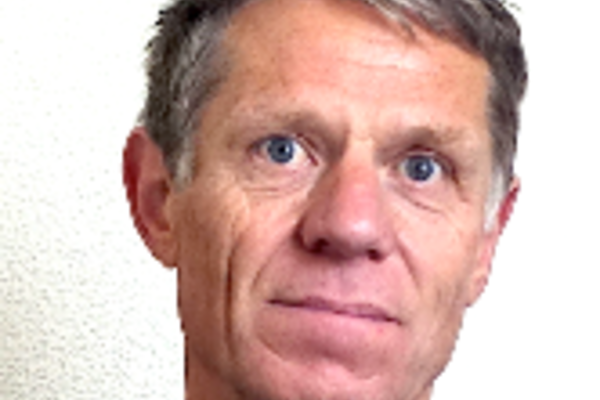
Walter Aeschimann
Walter Aeschimann lives and works as a freelance multimedia-journalist in Zurich, Switzerland. I studied history and german and finished also a postgraduate degree in Environmental Sciences. I worked as Editor of News Magazine FACTS, Sundy Newspaper and Journal maker Tages Anzeiger. I was Editor of Schweizer Fernsehen (Swiss Televison), amongst other things as Correspondent in Geneva (Coverage of national and international issues of daily news and background programs such as 10v10 and Rundschau. United Nation’s reports. Several long time foreign reports). At the moment I work especially for the daily newspaper Neue Zürcher Zeitung and magazines like Velojournal and PIZ. The topics are background themes in outdoor, mountain, environmental and sports in society. As a long-term project I am working on a dissertation. Born on August 6, 1957. I grew up on my parents’ farm in Kyburg near Winterthur. Political activities since 1980. I was an unsalaried longtime social, cooperative and environmental worker in the City of Zurich. Currently I am committed to the Autonome Schule Zürich. Treasurer of great literature and spoken theater. I undertook extensive mountain and bike tours, and sailed by catamaran from France to Guadeloupe. I lived abroad, six months in Bolivia and two months in Peru.
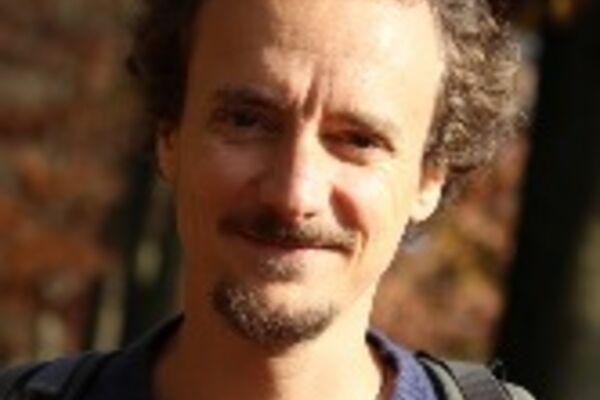
Simone Bobbio
Free-lance journalist, living and working in Torino, Italy. He has been professionally writing about mountains since 2005 collaborating with Italian and French magazines (Alp, Meridiani Montagne, Montagne 360, Montagnes Magazine, Rivista della Montagna, Slow Food, Vertical), newspapers (La Stampa, Il Manifesto), radio (Radio Flash, Radio Beckwith Evangelica), and television (Alpchannel). He likes to deal with problematic issues regarding sports, culture, politics, economy, tourism and environment. Through his historical background he is interested in studying the traditional aspects of Alpine societies and their contemporary interpretation which will guarantee a new life for the Alps.
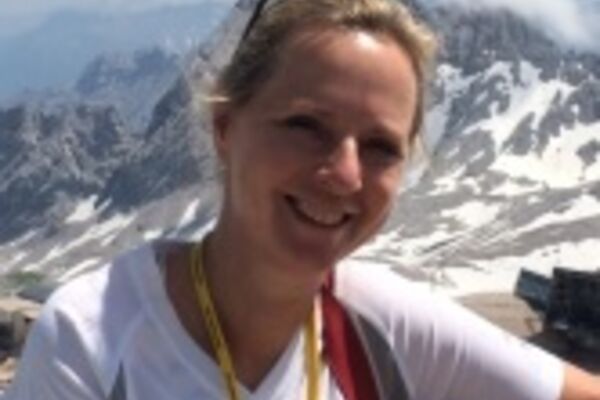
Christine Brugger
Christine Brugger is CEO and editor of Radio Osttirol in Lienz, Tirol. She started her career in radio business right after the liberalisation of the Austrian Broadcast in 1998 at Radio Frequenns (grass root media) in the Ennstal. She took over the principles of plurality of opinion from then to the day-to-day programme of Radio Osttirol. Her motivation to make radio programme is both curiosity and passion. Radio Osttirol is located in Osttirol with its Nationalpark Hohe Tauern and the river Isel. Therefore she reports about topics such as protection of nature and environment, Natura 2000 and hydropower plant projects because of their importance within the transmission area. These topics get more editorial attention as you would assume in the programme of a local radio station. Radio Osttirol has been nominated as „Best News Broadcast“ at the 1. Austrian Radio Award 2015 with the „Mittagsmagazin“ , a daily magazine with news and reports from our transmission area at noon. Beyond that Christine Brugger, who studied horticulture, works as a presenter at events and trainer in media education.
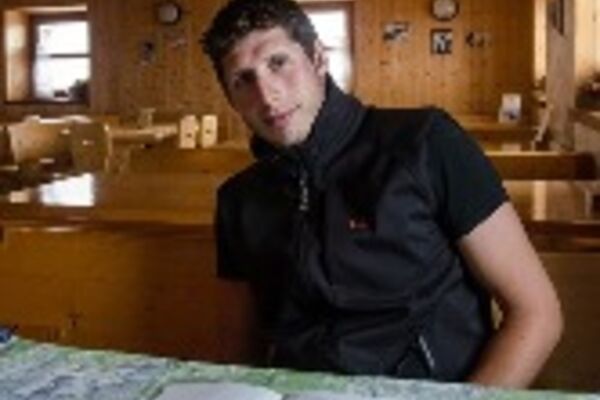
Alessandro Cristofoletti
Alessandro Cristofoletti was born in the 1983.He works as a photographer and writer with some italian Magazines and Newspapers, as Meridiani Montagne, DOVE and Repubblica. He started to work in tourism and culture since 2008, the year of his degree in Cultural Heritage at the University of Trento. Until now he has realized several projects related to active tourism and travel, like UNESCO by bike project (a long journey across the italian UNESCO's sites using the bike for the movements). He published a guide/travel book on a long trail in the Dolomites of Brenta called Dolomiti di Brenta Trek. Currently he is working with many tourist offices to promote walking routes using torytelling. Now he has a new big project: Dolomites Stories. The guideline of this production is telling the territories and the culture of the Dolomites with the stories of them, using pictures, videos and writing. These stories are about people, mountains, architecture, crafts, and any other subject who has something interesting to tell.
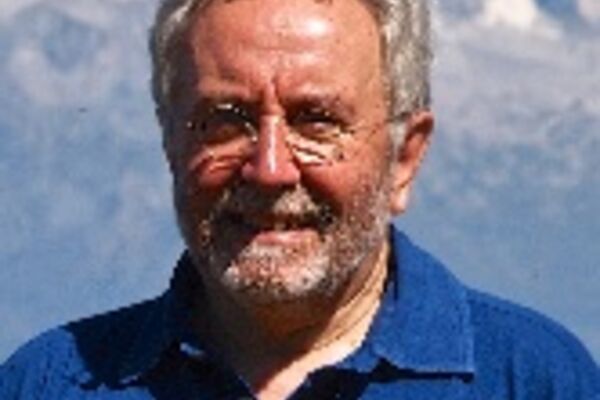
Oscar del Barba
Oscar del Barba, architect and urban planner (born in Lecco in 1950) lives in Morbegno. He’s member of CAI - Italian Alpine Club since 1967 where he is in charge of the Technical Secretariat for the Environment. He was the director of the Parco delle Orobie Valtellinesi 1998-2000. From 1980 to 1998 he was director in the Lombardy Region, where he mainly worked in the environmental sector and has directed and produced numerous projects, including the relocation of refinery Agip in Rho-Pero, on whose grounds stands the Nuova Fiera di Milano. He had completed the first regional plan for the waters of the Lombardy Region and initiated the construction of the waste water treatment system of Milan in 1996. He also created and directed a lot of projects funded by the EU and applied bioremediation techniques in agricultural areas polluted. From 1992 to 1998 he was a member of the Technical Committee of the Po River Basin Authority; from March 2008 to January 2014 Oscar del Barba was the President of CIPRA Italy. He was also a member of the National Council of the Environment of the Ministry of Environment, Land and Sea. He is following the activities of the Alpine Convention since 1994 and participates in the Italian delegation to the Permanent Committee during since 2013. In 2014, he promoted in the City of Morbegno the Info-point of the Alpine Convention. He loves hiking, cycling and is also a passionate sommelier.
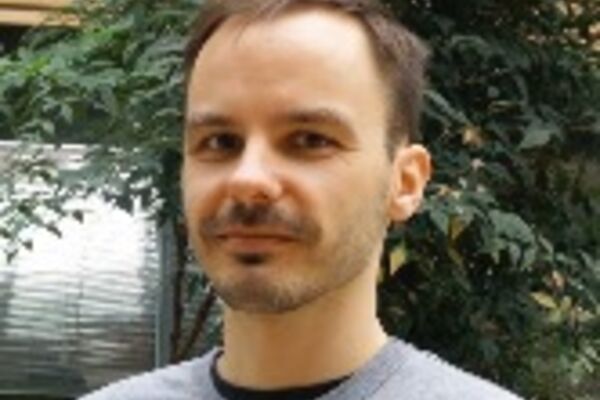
Richard Landgraf
Richard is a Scientific Policy Adviser at the German Environment Agency. In this position, he is coordinating the work of the Ad hoc expert group on the elaboration of the Sixth Report on the State of the Alps on the topic “Greening the Economy in the Alpine Region”. He studied economics with a specialization on environmental and energy topics. Richard is interested in strategies and policies for sustainable development and in transformation processes towards a Green Economy. The outstanding nature and landscape, the impressive cultural diversity, and the creativity of the people in the Alps are the reasons for Richard’s interest in this unique region.
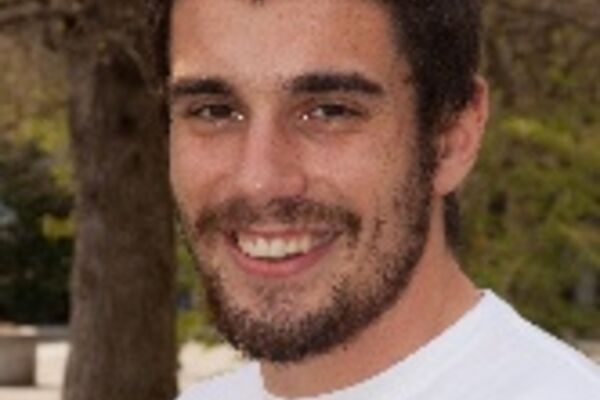
Filippo Marinoni
26 years old, employee at Associazione Ars.Uni.VCO. Responsible for the first Alpine Convention’s Infopoint set in Domodossola. He participated in the previous edition of WE ARE ALPS. He partook in the New Generations for the Alps project, sponsored by the Italian Presidency of the Alpine Convention. He is interested in the whole aspects of mountain’s life: ecology, economy, customs, sports and many other aspects, including communication.
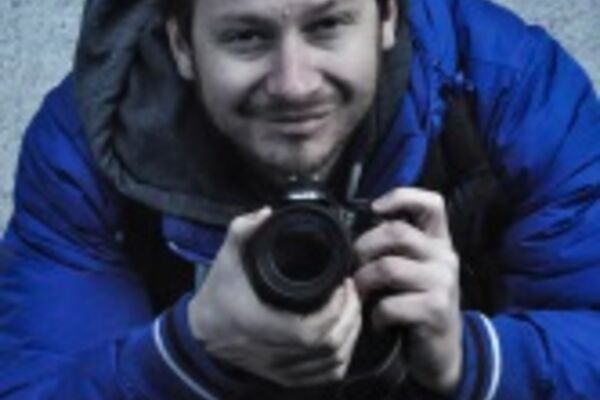
Peter Močnik
Peter is a journalist at the National radio of Slovenia covering all sorts of topics from ecology, environment, health and food to every-day social topics and also political issues. He is an active member of the World Federation of Travel Journalists and Writers (FIJET Slovenia). He loves traveling around the world and reporting for the radio and different travel, tourism or ecology oriented magazines and newspapers.
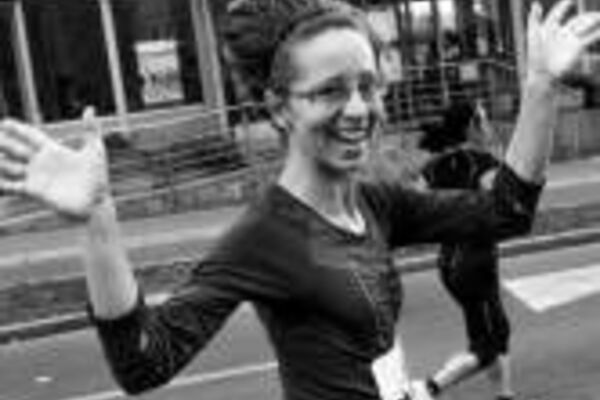
Maja Prijatelj Videmšek
My name is Maja Prijatelj Videmšek and I'm a journalist from main Slovenian newspaper Delo. I cover wide area of topics ranging from social issues, food and health to environment and ecology. I was the initiator of weekly page in Delo about environmental topics and also write for it. Privately I'm a big nature and animal lover and enthusiastic gardener.
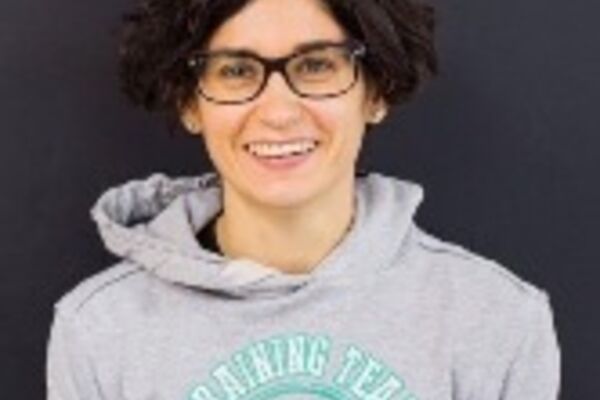
Veronica Ulivieri
Veronica is a freelance journalist and contributor for many Italian newspapers (La Stampa, Repubblica Affari&Finanza, Il Fatto quotidiano, Inform-ant.com, Econewsweb.it, Eticanews.it). She usually covers environmental and economic stories, with particular attention to European policies. In the past she also collaborated with the scientific organization EvK2Cnr, during their international conference on mountain and climate change (Lecco, Italy, 2013). She was born and raised in Tuscany near the sea, but she loves the Alps. In 2015 she was awarded by Ugis, the Italian Union of Scientific Journalists, for her commitment to scientific communication.










































